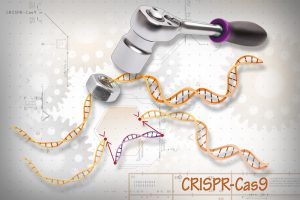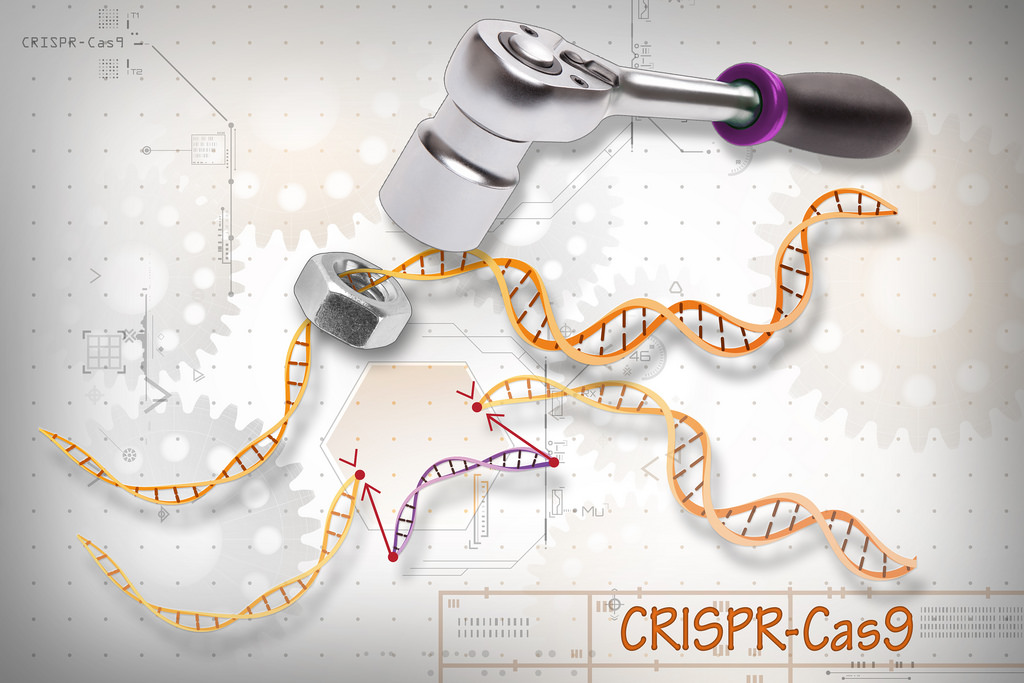CRISPR (clustered regularly interspaced short palindromic repeat)/Cas9 is a gene editing technique that utilizes a viral vector to insert segments of viral DNA to provide a template for RNA molecules that can be programmed to identify, disable, and or replace any gene sequence within the host’s genome. CRISPR/Cas9 gene editing hypothetically can identify single or multiple loci that contribute to a given pathology, ablate them from the genome, or replace them with functional gene sequences. As such, monogenic disorders such as Li-Fraumeni syndrome (TP53), cystic fibrosis (CFTR), and sickle cell anemia (HBB) can potentially be cured by eradication from a genetic lineage. Polygenic disorders, however, such as cancer, Alzheimer disease, and cardiovascular diseases, pose further challenges as not all pertinent pathways and disease-driving biomarkers have yet been identified.
 Upon its inception, CRISPR/Cas9 technology was met with a lot of optimism with regards to potential use in therapeutics and research, and that still remains the case to date despite frequent reports of off-target gene editing. There are 2 main types of viral vectors: integrating vectors that incorporate their genomes into the host genome (retroviral and lentiviral vectors) and non-integrating vectors that do not integrate and remain as plasmids, such as adenoviral and adeno-associated virus (AAV) vectors. Each class of viral vectors presents its own limitations. Integrating vectors have been shown to incorporate within oncogenes and induce oncogenesis while non-integrating vectors contain plasmid coat proteins that induce inflammatory responses. In order to mitigate this issue, non-viral modes of delivering CRISPR/Cas9 were developed. Cas9 ribonucleoproteins (RNP) are recombinant Cas9 proteins complexed with in vitro transcribed chimeric single-guide RNAs. Cas9 RNPs are delivered into the cell by electroporation, utilizing electrical fields to make cell membranes more permeable. The benefit of this is that RNP and Cas9 proteins are rapidly degraded after delivery in cells, reducing off-target effects that are seen in viral vectors that persist long after delivery.
Upon its inception, CRISPR/Cas9 technology was met with a lot of optimism with regards to potential use in therapeutics and research, and that still remains the case to date despite frequent reports of off-target gene editing. There are 2 main types of viral vectors: integrating vectors that incorporate their genomes into the host genome (retroviral and lentiviral vectors) and non-integrating vectors that do not integrate and remain as plasmids, such as adenoviral and adeno-associated virus (AAV) vectors. Each class of viral vectors presents its own limitations. Integrating vectors have been shown to incorporate within oncogenes and induce oncogenesis while non-integrating vectors contain plasmid coat proteins that induce inflammatory responses. In order to mitigate this issue, non-viral modes of delivering CRISPR/Cas9 were developed. Cas9 ribonucleoproteins (RNP) are recombinant Cas9 proteins complexed with in vitro transcribed chimeric single-guide RNAs. Cas9 RNPs are delivered into the cell by electroporation, utilizing electrical fields to make cell membranes more permeable. The benefit of this is that RNP and Cas9 proteins are rapidly degraded after delivery in cells, reducing off-target effects that are seen in viral vectors that persist long after delivery.
One of the more exciting applications of this method of gene editing is the ability to support current clinical therapies. Gene editing and immunotherapy are a logical match, especially in a setting where genetic obstacles impede therapeutic efficacy or, worse, cause adverse effects. Chimeric antigen receptor (CAR) are engineered receptors that can be conjugated to T cells to provide the specificity and affinity for tumor specific antigens (imagine the efficacy of monoclonal antibodies, attached to a T cell). A common issue with CAR is the use of autologous T cells which possess T-cell receptors (TCR), human leukocyte antigen-1 (HLA-I), and PD1 surface markers that would make it susceptible to graft-versus-host disease. With CRISPR, it is possible to create so called universal T-cells that do not express endogenous TCR, HLA-I, and PD1 simultaneously. This concept is currently undergoing a clinical trial at Guangzhou Institute of Respiratory Disease, where PD1 and the endogenous TCR will be knocked out by CRISPR/Cas9 in NY-ESO-1 TCR-transduced T cells of patients with lung cancer. Preliminary results have shown favorable progression-free survival times without any severe side effects, a very promising sign.
- Shoshan D. CRISPR: The Scientific Breakthrough of 2017. The Differential. March 8, 2016. http://www.thedifferentialdx.com/crispr-the-scientific-breakthrough-of-2015
- Thomas CE et al. Progress and problems with the use of viral vectors for gene therapy. Nature Reviews Genetics. 2003; 4: 346-358. doi: 10.1038/nrg1066.
- Ren J & Zhao Y. Advancing chimeric antigen receptor T cell therapy with CRISPR/Cas9. Protein & Cell. 2017. doi: 10.1007/s13238-017-0410-x
- https://clinicaltrials.gov/ct2/show/NCT03029273
- Kim S, Kim D, Cho SW, Kim J, Kim J-S. Highly efficient RNA-guided genome editing in human cells via delivery of purified Cas9 ribonucleoproteins. Genome Research. 2014; 24(6):1012-1019. doi: 10.1101/gr.171322.113
Ogaga Ojameruaye is a medical student at The University of Arizona College of Medicine – Phoenix. He completed his BS in physiology at The University of Arizona and completed his MS in psychology at Grand Canyon University. Ogaga is passionate about translational medicine, bench-to-bedside research, and the discovery of new diagnostic tools as they contribute to the model of precision medicine.


